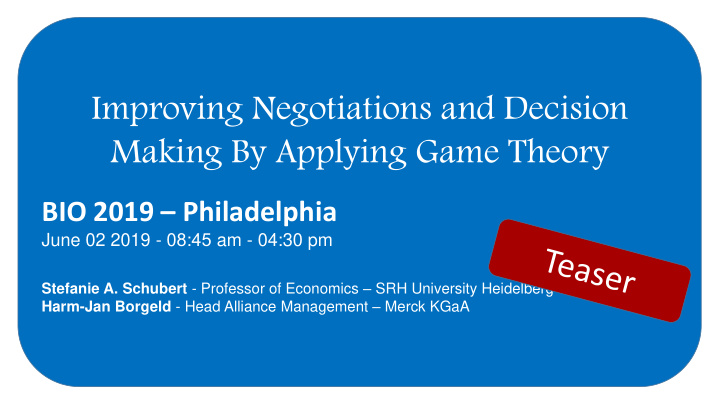



Improving Negotiations and Decision Making By Applying Game Theory BIO 2019 – Philadelphia June 02 2019 - 0 8 : 45 am - 04:30 pm Stefanie A. Schubert - Professor of Economics – SRH University Heidelberg Harm-Jan Borgeld - Head Alliance Management – Merck KGaA
Objective of the Workshop This workshop covers … By participating in this workshop, you will learn how to: Methods: • • Improve your decision making by acquiring a systematic framework for decision Real-life pharma/biotech making using Game Theory. cases • • Achieve better negotiation results by applying advanced negotiation Game theory techniques . • In-class exercises • Enhance your influencing skills by applying learnings from the Alliance Management practice. • Master new strategies to steer business interactions. Participants will leave the workshop with a negotiation and decision making toolkit specifically designed for Business Development Professionals. 2
Game Theory Strategic Decision Making Is the science of strategic decision making Offers a useful framework for assessing the options and analyzing decisions Unveils your partner’s choices Enables you to influence the outcome Look ahead and reason back to achieve the desired outcome 3
In-Class Exercise : First & Second Offer Strategy in Negotiations In-class exercises The rules of the game: 2 players and two piles of bricks The player who has to make the next move picks one of the piles and removes some bricks Number of bricks to be removed: one, all or any number in between Players move sequentially The player who gets the last stone wins If there is a first mover advantage: go first (often advantageous) Lesson: If there is a second mover advantages: make you opponent go first (e.g. informational disadvantage)! 4
Multiple Equivalent Simultaneous Offers (MESO) Negotiations Useful in collecting Use MESOs if the information from counterparty .. the partner is not willing to Be creative and share information provide multiple options that have does not reveal the same value priorities This signals cooperation 5
Case Study: Scandinavian Pharmaceuticals’ Decision on the Project with M Biotech Case studies Mediterranean Pharmaceuticals and Scandinavian Biotech have just finalized next year’s budget for four projects. A month later at an internal decision making committee of Mediterranean a additional clinical study for 2019 is proposed. The new study is not part of next year’s budget If Mediterranean does propose the study it will lead to issues with Scandinavian on the budget. At an internal decision making committee of Scandinavian concerns about one of the budgeted projects were made. If Scandinavian does bring up the possible cancellation of the project it will lead to issues with Mediterranean. What should both companies do? 6
Look at All Options at the Same Time Harvard Business Review: examine one option at a time (sequential DM) or review all our DM options together People were on average 22% more likely to chose the best option when they viewed all options together rather then one at a time Websites – companies tend to show one product at a time…… To make better choices look at all your options at the same time Basu and Savani, HBR, June 28, 2017 7
Case Study: John and the Phase III Study Design #1 Case studies John his first meeting in the afternoon was with Carla Christiansen, Head of Clinical Development. Carla would like to receive John’s approval for the Phase III study design for the company’s lead oncology compound, Diatuzumab. The company had conducted a successful Phase II study and for both active arms, the high dose (40 mg/kg) and the low dose (5 mg/kg), the endpoint was met. Carla has been impressed by the data and makes her case that Diamond Pharmaceuticals should go forward with a Phase III study with a high dose arm. The efficacy of a high dose is impressive. Ovarian cancer is a difficult cancer type to treat, but Diatuzumab might be able to overcome the hurdle where many other compounds failed. John asks Carla to show the slide with the efficacy data. On first sight, the high dose was the best option but the low dose was not far off. ………………... ..tbc Should John decide for either the high-dose or low-dose arm? 8
Case Study: John and the Phase III Study Design #2 John vs Kylie Kylie John’s payoffs : high dose low dose If he decides for … - Kylie decides for…: High - high: 50% of $4B-$1B costs = 1 high dose 1,1 2,0.5 High - low: 75% of $4B-$1B costs = 2 John Low - high: 25% of $4B-$0.5B costs = 0.5 0.5,2 1.5,1.5 low dose Low - low: 50% of $4B-$0.5B costs = 1.5 9
Case Study: John and the Phase III Study Design #3 high (2, 2 ) dose Kylie John high dose vs Kylie low dose (2, 0.5 ) John high (0.5, 2 ) What if Kylie is informed dose Kylie about John’s decision? low dose Solving the game: low Look ahead and reason back dose (1.5, 1.5 ) 10
Course Facilitators: Stefanie Schubert & Harm-Jan Borgeld Professor Stefanie Schubert, PhD CA-AM Professor of Economics at SRH University Heidelberg. Previous position: Assistant Professor of Organization Theory Expertise: strategic decision making, managerial economics, and Management at WHU (Vallendar/Düsseldorf) strategic alliances/networks. Consultant for strategic management lllllllllllllllllllllllllllllll We are looking forward to seeing you in Harm-Jan Borgeld, PhD MBA CSAP Head of Alliance Management at Merck KGaA. Responsible Received his MBA: RSM, NL/Haas Business School, USA; for the Commercial, Development, Research, and selected Ph.D: Faculty of Medicine, University of Nagoya, Japan. Regional Alliances. 11
Recommend
More recommend